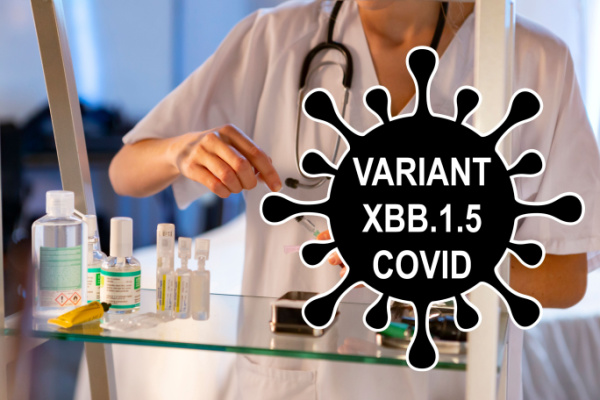The newest COVID-19 variant is so contagious, experts are saying that even people who’ve avoided it so far are getting infected and the 80% of Americans who’ve already been infected are likely to catch it again, as reported by USA Today.
Essentially, everyone in the country is at risk for infection now, even if they’re super careful, up to date on vaccines or have caught it before, said Paula Cannon, a virologist at the University of Southern California. “It’s crazy infectious,” said Cannon, who is recovering from her first case of COVID-19, caught when she was vacationing over the holidays in her native Britain. “All the things that have protected you for the past couple of years, I don’t think are going to protect you against this new crop of variants,” she said.
The number of severe infections and deaths remains relatively low, despite the high level of infections, she said, thanks to vaccinations – and probably – previous infections. But the lack of universal masking means that even people like her, who do mask, are vulnerable.
The latest variant, called XBB.1.5, grew exponentially over the month of December, from about 1% of cases nationwide to 40% as of December 31, according to data from the Centers for Disease Control and Prevention‘s COVID Tracker. The variant is likely behind the vast majority of cases in New York and New England.
Its growth is probably due to XBB.1.5’s characteristics – it appears to bind even more tightly to receptors in the human body than its predecessors – as well as human behavior, such as traveling and not masking.
It’s a good idea to do what you can to avoid getting infected, said Dr. Ziyad Al-Aly, chief of research and development at the VA St. Louis Health Care System and a clinical epidemiologist at Washington University in St. Louis. It’s still early and there are a lot of unknowns about XBB.1.5, he said. Every infection makes someone vulnerable to a bad course of the disease and to the lingering, miserable symptoms of long COVID, Al-Aly’s research shows. “Reinfection buys you additional risk,” he said.
COVID-19 symptoms typically last around five to seven days and can include fever, sore throat, muscle aches, exhaustion, nausea, cough and sinus congestion, among other problems. Symptoms with XBB.1.5 are the same as with earlier variants and can range from almost nothing to shortness of breath and low oxygen levels that require emergency medical attention.
Early in the pandemic, COVID-19 often cost people their sense of taste and smell, at least temporarily, but that symptom seems less common now, possibly because of vaccination or previous infection rather than a change in the virus, said Dr. Peter Hotez, an infectious disease specialist and co-director of the Center for Vaccine Development at Texas Children’s Hospital.
It’s a good idea to have a plan ready in case you get sick, Cannon said. She suggests every plan include:
- How to isolate from others in your household
- The contact number for a health care provider who can prescribe an antiviral
- Equipment such as rapid coronavirus tests, extra masks, a thermometer and a pulse oximeter to make sure the patient’s blood oxygen level doesn’t drop below the low 90s
Every U.S. household is eligible for four free coronavirus tests from the government that can be ordered from this link: covid.gov/tests.
For someone over 60 or with medical conditions like obesity that raise the risk for serious disease, the first step after a positive test should be a call to the doctor to get the antiviral Paxlovid, she and others said. The government has pre-bought millions of doses, so they are available for free.
Some doctors are hesitant to provide the antiviral because people may need to stop taking common medications during the five-day treatment course, but it’s essential for people at high risk for serious disease, Hotez said. “Any senior going on Paxlovid is not dying,” he said. “We can’t stop people getting infected,” Cannon added, “but we absolutely can stop people from being seriously ill. Gosh, why wouldn’t you take it?”
Every COVID-19 infection increases your risk for serious disease and for long COVID, which brings sometimes debilitating symptoms that can linger for a year or more. Vaccination reduces the risk of long COVID by 15% to 30%, according to a study he recently published. Another study he is working on shows Paxlovid reduces the risk by 26%.
Cannon’s daughter works in a long COVID clinic and regularly sees patients who are in their 20s or 30s, “healthy people who didn’t even have a particularly bad bout of COVID who now have a massively debilitating set of symptoms.”
COVID-19 has been perhaps the most successful virus in all of human history, Cannon said, infecting billions of people across the planet. While she worries about how it might continue to evolve, she hopes it’s a good sign that for the last year, all the variants have been descendants of omicron.
Before that, the original virus, alpha, beta and delta had been “radically” different from each other. “The virus is now in this committed lineage,” Cannon said, which might mean it won’t evolve away from the protection against serious disease that nearly everyone now has from vaccinations and previous infections.
—
Photo Credit: Fernando Astasio Avila / Shutterstock.com
